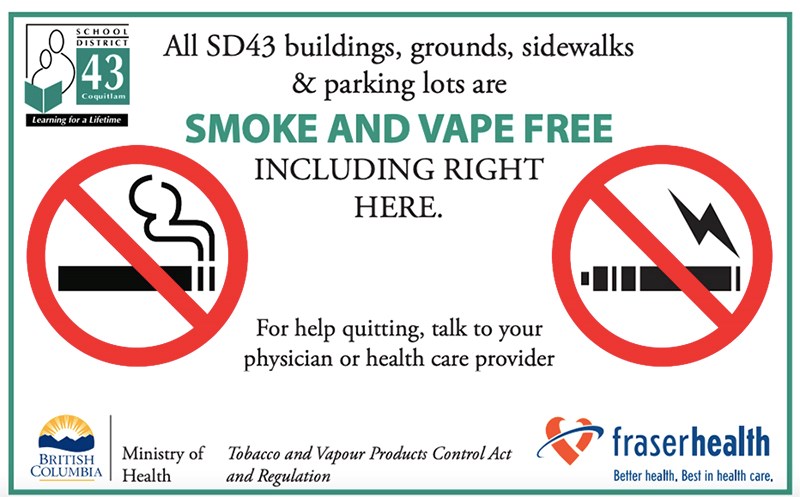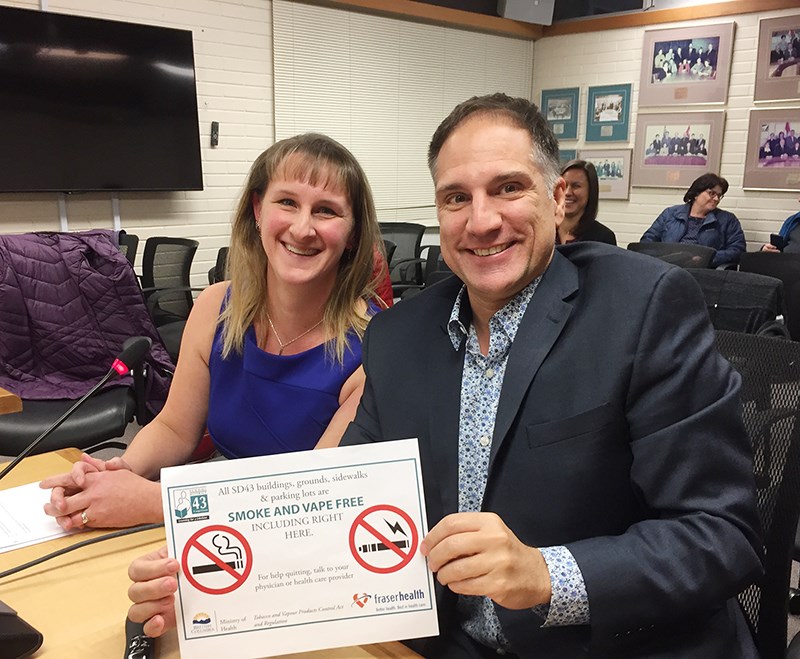As more reports emerge across North America about sickness and deaths related to vaping, School District 43 and Fraser Health are teaming up to urge youths to think twice before they start puffing.
Combating youth vaping is the goal of a new education program geared to middle school and secondary school students. The program, which is being introduced to Grade 5 to 7 classes this fall, will include videos, presentations and resources, and and is aimed at debunking popular myths that vaping is harmless, said SD43 assistant superintendent Rob Zambrano.
It was developed over the summer by Diana Dickin, a Fraser Health public health nurse, who surveyed resources to find the best way to convey facts to students without lecturing them.
Zambrano said the district had to act fast because schools are dealing with vaping on a regular basis, with as many as 134 suspensions last year for vaping or being in possession of vape products on school grounds, up from four suspensions the year before — more than a 3,200% increase.
Zambrano said the suspended students are likely repeat offenders who had one vape device confiscated and likely offended again because they were addicted to vaping.
“It’s not supposed to be on school property. Youth in B.C. under 19 should not be in possession, and it’s not appropriate for adults to give nicotine or vape products [to youth], so it’s very clear,” he said.

Dickin and Zambrano gave a presentation to the board of education Tuesday, and with roughly 20% of B.C. students reporting in a McCreary adolescent health survey they had tried vaping, the two said it’s important to provide students with facts so they can make healthy choices.
“It plants those seeds and thoughts so students can make those health decisions down the road,” Dickin said.
Among the resources is a tool kit for younger students and curriculum for teachers, who can use the resources to include the topic of vaping in various subjects, from health to chemistry. There will also be a poster contest for students on health facts for vaping.
SFU community health students will be presenting the lessons to younger students while a student ambassador program is being developed so peers can work with peers on the topic.
Zambrano said Share Family and Community Services, which provides drug and alcohol information for students, will be involved in a program that encourages students to consider their family and health values when making choices.
One of the challenges will be helping students understand the impact of nicotine addiction, a problem faced by educators decades ago. Public education curtailed cigarette smoking and Zambrano said he hoped a similar thing could be done with vaping.
“It took us 40 to 60 years to shift away from smoking, I think this will be quicker,” he said.

SD43’s push for more vaping education comes as the BC School Trustees Association (BCSTA) calls on the provincial and federal governments to provide funding for vape education and cessation.
Coquitlam Trustee Carol Cahoon said a motion was passed at a recent BCSTA meeting because trustees are concerned about all the efforts going into dealing with vaping on school grounds, and the issue of nicotine addiction among youth
Other trustees expressed concern about youths using vaping products not knowing how much nicotine is in them.
“Now we’ll get some real information out there,” said Jennifer Blatherwick, another Coquitlam trustee.
Anmore/Belcarra Trustee Kerri Palmer Isaak admitted she was one of the “gullible” parents who thought “It’s just water vapour,” and relayed an anecdote about students being “grumpy” at a graduation function because they had to wait six hours before being able to vape.
Fraser Health’s Dickin said students need help with quitting nicotine-infused vape products and said QuitNowBC, a provincial quit-smoking program, is developing supports for people wanting to quit vaping.
“It’s not here yet, but it’s in the works,” she said.
Trustees agreed to spend $10,000 on decals that will be placed in and around schools reminding students that vaping is not allowed.



